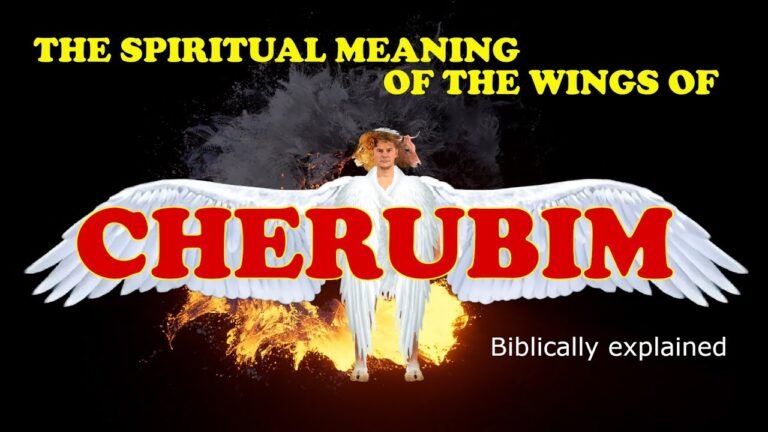Understanding the Role of Cherubs in the Bible
The cherub in the Bible is a fascinating symbol that transcends mere imagery to embody divine presence and protection. Often depicted as celestial beings with a mix of human and animal features, cherubs serve as guardians of sacred spaces and messengers of God’s will. Their enigmatic roles in scripture, particularly in the contexts of the Garden of Eden and the Ark of the Covenant, invite deep exploration into their significance within the biblical narrative. As we delve into the multifaceted nature of cherubs, we uncover not only their theological implications but also their lasting impact on art, literature, and spiritual thought throughout history.
What role do cherubs play in the Bible?
Cherubs in the Bible are angelic beings often associated with God’s presence, guarding sacred spaces, and symbolizing divine protection and glory.
What is the symbolism of cherubs?
Cherubs, often portrayed as chubby, winged children, hold a significant place in Christian art and popular culture. Their innocent appearance conveys a sense of purity that resonates deeply with themes of divine love and protection. These angelic figures evoke a feeling of warmth and comfort, making them a beloved symbol of childhood and innocence.
Beyond their visual charm, cherubs serve as a reminder of the virtues associated with innocence and playfulness. They embody the idea of untainted joy, representing a connection between the earthly and the divine. In various artworks, these whimsical beings often appear in serene, heavenly settings, reinforcing their role as messengers of peace and goodwill.
The cultural impact of cherubs extends beyond religious contexts, influencing art, literature, and popular imagery. From classic masterpieces to modern interpretations, their enduring presence highlights a universal appreciation for the qualities they symbolize—innocence, purity, and the divine connection found in the simplicity of a child’s heart. Cherubs, therefore, remain a timeless emblem of hope and love across generations.
What distinguishes a cherub from an angel?
Angels and cherubim both captivate our imagination with their enigmatic nature, yet they possess distinct characteristics. Angels, often depicted with human-like qualities and names in the Bible, engage in communication that mirrors our own, and intriguingly, they are not typically described with wings. In contrast, cherubim present a more fantastical image, featuring a blend of human and animal traits, complete with wings that enhance their otherworldly presence. This distinction highlights the rich tapestry of celestial beings in religious texts, each serving unique roles in the spiritual narrative.
What does cherub mean in biblical Hebrew?
Cherubim, derived from the Hebrew word “keruv,” are enchanting, winged creatures featured prominently in the Hebrew Bible. Often depicted as guardians, these beings embody divine presence and protection, serving as a bridge between the heavenly and earthly realms. Their striking imagery and significance have captivated the imagination of scholars and believers alike, contributing to their enduring legacy in religious texts and traditions.
In biblical narratives, cherubim are frequently associated with the divine, appearing in key moments such as the guarding of the Garden of Eden and the design of the Ark of the Covenant. Their role as protectors and symbols of holiness highlights their importance in conveying messages of faith and reverence. As such, cherubim continue to inspire awe and curiosity, inviting deeper exploration into their meaning and representation across various cultural contexts.
Exploring Celestial Messengers in Scripture
Throughout history, celestial messengers have captivated the imagination and faith of many, serving as divine intermediaries between the heavens and humanity. In various scriptures, these beings—often depicted as angels—carry profound messages of hope, guidance, and warning. Their appearances are not merely symbolic; they reflect a deep spiritual connection that transcends earthly existence. Each encounter, whether in the form of a gentle whisper or a resounding proclamation, invites believers to reflect on their purpose and the greater cosmic order.
These celestial entities often play pivotal roles in shaping the narratives of faith, illustrating the power of divine intervention in human affairs. From the annunciation of significant events to the delivery of critical revelations, their presence emphasizes the importance of listening to the divine call. As we explore these scriptural accounts, we gain insight into the nature of faith itself—an invitation to embrace the unknown and trust in a higher wisdom that guides us along our paths. Through the lens of these celestial messengers, we can better understand the intricate tapestry of belief that connects us to the cosmos and to one another.
The Symbolism and Significance of Cherubs
Cherubs, often depicted as chubby, winged infants, hold a profound place in art and religious symbolism. Their representation transcends mere aesthetics; they are seen as messengers of divine love and guardians of sacred spaces. In various cultural contexts, cherubs embody purity and innocence, serving as a reminder of the divine presence that watches over humanity. Their playful demeanor invites viewers to reflect on the joy and comfort that faith can bring.
In Christian theology, cherubs are not only associated with the heavenly realm but also with the protection of the sacred. They are frequently depicted in biblical narratives, such as guarding the entrance to the Garden of Eden or surrounding the throne of God. This duality of innocence and vigilance speaks to their role as intermediaries between the divine and the earthly, symbolizing the connection between humanity and the celestial. Their presence in religious art inspires awe and reverence, inviting contemplation of the mysteries of faith.
Beyond their religious significance, cherubs have permeated popular culture and art, often representing idealized childhood and untainted love. They evoke a sense of nostalgia and warmth, reminding us of simpler times and the purity of human connection. Whether in classical paintings or modern interpretations, cherubs continue to resonate, symbolizing hope, protection, and the enduring nature of love in our lives. Their imagery invites us to embrace the lighter aspects of existence while acknowledging the deeper spiritual truths they represent.
Unveiling the Mysteries of Heavenly Guardians
Throughout history, cultures across the globe have revered celestial beings as protectors of humanity, often attributing them with the power to guide and inspire. These heavenly guardians, whether depicted as angels in religious texts or as ethereal spirits in folklore, embody the hope and strength that individuals seek in times of uncertainty. By exploring their fascinating narratives and the roles they play in human lives, we uncover a rich tapestry of beliefs that not only illuminate our understanding of the cosmos but also offer solace and motivation in our everyday struggles. As we delve deeper into these celestial mysteries, we find that the guardians above serve as a reminder of the interconnectedness of all beings and the enduring quest for peace and enlightenment.
The cherub in the Bible stands as a powerful symbol of divine presence and protection, embodying both mystery and majesty. Their multifaceted roles, from guardians of sacred spaces to messengers of God, reflect the profound complexities of the spiritual realm. As we delve deeper into the scriptures, cherubs invite us to explore the intersection of the celestial and the earthly, reminding us of the ever-watchful guidance that surrounds us. Embracing their significance enriches our understanding of faith and the divine narrative that shapes our world.







